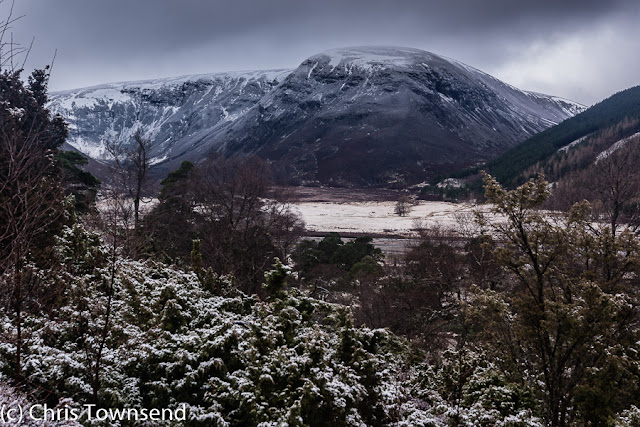 |
| Glen Feshie, March, 2016 |
Just over a year ago I turned back from the tops on a stormy day. This is the piece I then wrote for The Great Outdoors magazine.
The forecast was for clearing skies, sunny periods and light
winds. Dawn was promising. I woke in my camp in Glen Feshie to a hard frost and
a blue sky. Soon there was sunshine on the still-snowy tops. However by the
time I’d had breakfast and packed up clouds were building again in the sky and
a chill wind was sweeping down the glen. I went up anyway, climbing through the
forest until I came out of the trees to a heathery hillside lightly dusted with
snow. Here the wind was stronger and colder and I could see the higher summits
were cloud-capped. Less sure now I continued upwards. Did I really want to do
this? My plan was for a high level traverse along the western edge of the Moine
Mhor plateau. Expecting some deep snow up there I’d brought snowshoes, adding
to the weight of my pack.
The snow deepened and soon I was walking on its crusty
surface rather than breaking through into boggy ground. Mist came and went. I’d
reached the base of the clouds. At a wind ruffled little lochan I paused. My
desire to go on was waning fast. Several hours navigating in minimal visibility
and a bitter wind lay ahead. There would be no joy in this. It wasn’t necessary,
as it sometimes is when the weather closes in and you’re already up there. I
could be walking along the glen instead, through the magnificent pines, beside
the rushing river. Where would I rather be? The answer came immediately. Down
there. Turning I slipped and slithered down the snowy hillside, feeling
relieved. The walk down the glen was pleasant. The hills stayed in the cloud. I
had missed nothing.
 |
| The point where I turned back |
Deciding to turn back and change a planned route can be
hard. On this occasion, an overnight trip in familiar country, it wasn’t but
there have been other times when only really big storms have persuaded me that
my intended route would not be enjoyable and could be risky. Partly it depends
on the aim of the walk. When peak bagging it’s very difficult to turn away from
a new summit. Having climbed the Moine Mhor tops many times I wasn’t feeling
any pressure to reach them. On walks that don’t involve collecting summits
planning alternative routes means the walk can easily continue if you abandon a
high level one. The TGO Challenge requires participants to submit such
alternatives and on quite a few occasions I’ve taken them, reminding myself
that I’m there to enjoy myself not suffer unduly by persisting with a high
level route in bad weather.
The one walk I’ve done where alternative routes were not an
option was my summer long round of the Munros and Tops, the only peak bagging
long distance walk I’ve undertaken. As the whole point of the walk was to visit
517 tops I couldn’t stay low level on stormy days. Even so there were some
storms I had to wait out, storms where I could barely stand. On other long
distance walks I’ve often let the weather decide the route. Going high when
it’s fair, staying low when it’s stormy.
 |
| In the Ogilvie Mountains in the Yukon Territory |
Being flexible allows me to extract the best out of a walk,
rather than feeling forced to follow a rigid plan. Sometimes this can have huge
and unexpected rewards. One rainy day on my walk through the Yukon Territory I
stayed in the wooded valley rather than climb onto the cloud-shrouded hills above.
The forest was dark and dripping but full of life. I saw deer and moose,
squirrels and birds. I forgot the rain, forgot I’d hoped to be striding along
ridges high above, and revelled in the wildlife, walking quietly and alert for
every movement in the trees. It turned into a glorious day.

Excellent post, thank you Chris. Almost all experienced hill walkers know the sense in turning back to avoid unacceptable risk; however, I feel that fewer turn back simply because a walk will not give the pleasure originally hoped for. I used to be like that. If it wasn't dangerous I suppose I thought it a form of weakness to press on. With age I have changed my view and will turn back if the joy is lost. The joy does not have to be immediate, of course. We accept that hill walking can be more pleasurable looking back when the immediate discomforts of a steep slope or driving rain ir whatever have passed.
ReplyDelete